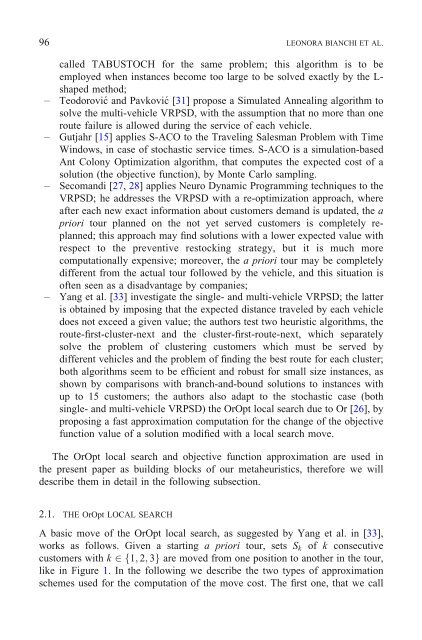Hybrid Metaheuristics for the Vehicle Routing Problem with ...
Hybrid Metaheuristics for the Vehicle Routing Problem with ...
Hybrid Metaheuristics for the Vehicle Routing Problem with ...
Create successful ePaper yourself
Turn your PDF publications into a flip-book with our unique Google optimized e-Paper software.
96 LEONORA BIANCHI ET AL.<br />
called TABUSTOCH <strong>for</strong> <strong>the</strong> same problem; this algorithm is to be<br />
employed when instances become too large to be solved exactly by <strong>the</strong> Lshaped<br />
method;<br />
– Teodorović and Pavković [31] propose a Simulated Annealing algorithm to<br />
solve <strong>the</strong> multi-vehicle VRPSD, <strong>with</strong> <strong>the</strong> assumption that no more than one<br />
route failure is allowed during <strong>the</strong> service of each vehicle.<br />
– Gutjahr [15] applies S-ACO to <strong>the</strong> Traveling Salesman <strong>Problem</strong> <strong>with</strong> Time<br />
Windows, in case of stochastic service times. S-ACO is a simulation-based<br />
Ant Colony Optimization algorithm, that computes <strong>the</strong> expected cost of a<br />
solution (<strong>the</strong> objective function), by Monte Carlo sampling.<br />
– Secomandi [27, 28] applies Neuro Dynamic Programming techniques to <strong>the</strong><br />
VRPSD; he addresses <strong>the</strong> VRPSD <strong>with</strong> a re-optimization approach, where<br />
after each new exact in<strong>for</strong>mation about customers demand is updated, <strong>the</strong> a<br />
priori tour planned on <strong>the</strong> not yet served customers is completely replanned;<br />
this approach may find solutions <strong>with</strong> a lower expected value <strong>with</strong><br />
respect to <strong>the</strong> preventive restocking strategy, but it is much more<br />
computationally expensive; moreover, <strong>the</strong> a priori tour may be completely<br />
different from <strong>the</strong> actual tour followed by <strong>the</strong> vehicle, and this situation is<br />
often seen as a disadvantage by companies;<br />
– Yang et al. [33] investigate <strong>the</strong> single- and multi-vehicle VRPSD; <strong>the</strong> latter<br />
is obtained by imposing that <strong>the</strong> expected distance traveled by each vehicle<br />
does not exceed a given value; <strong>the</strong> authors test two heuristic algorithms, <strong>the</strong><br />
route-first-cluster-next and <strong>the</strong> cluster-first-route-next, which separately<br />
solve <strong>the</strong> problem of clustering customers which must be served by<br />
different vehicles and <strong>the</strong> problem of finding <strong>the</strong> best route <strong>for</strong> each cluster;<br />
both algorithms seem to be efficient and robust <strong>for</strong> small size instances, as<br />
shown by comparisons <strong>with</strong> branch-and-bound solutions to instances <strong>with</strong><br />
up to 15 customers; <strong>the</strong> authors also adapt to <strong>the</strong> stochastic case (both<br />
single- and multi-vehicle VRPSD) <strong>the</strong> OrOpt local search due to Or [26], by<br />
proposing a fast approximation computation <strong>for</strong> <strong>the</strong> change of <strong>the</strong> objective<br />
function value of a solution modified <strong>with</strong> a local search move.<br />
The OrOpt local search and objective function approximation are used in<br />
<strong>the</strong> present paper as building blocks of our metaheuristics, <strong>the</strong>re<strong>for</strong>e we will<br />
describe <strong>the</strong>m in detail in <strong>the</strong> following subsection.<br />
2.1. THE OrOpt LOCAL SEARCH<br />
A basic move of <strong>the</strong> OrOpt local search, as suggested by Yang et al. in [33],<br />
works as follows. Given a starting a priori tour, sets Sk of k consecutive<br />
customers <strong>with</strong> k 2f1; 2; 3g are moved from one position to ano<strong>the</strong>r in <strong>the</strong> tour,<br />
like in Figure 1. In <strong>the</strong> following we describe <strong>the</strong> two types of approximation<br />
schemes used <strong>for</strong> <strong>the</strong> computation of <strong>the</strong> move cost. The first one, that we call
















